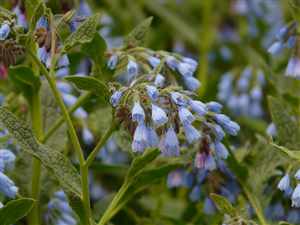Comfrey (Symphytum officinale)
Main Facts about Comfrey

Comfrey is a hardy perennial plant with large, hairy, lance-shaped leaves, a hollow, bristly stem, thick, spreading roots, and purple, pink, blue, or white bell-shaped flowers. It grows up to 3-6 feet (0.9-1.8 m) in ditches, streams, and other damp places through the summer. Parts used - leaves and roots.
It has been used as a medicinal plant since ancient times, and its botanical name refers to the plant’s traditional use to repair broken bones: Symphytum is from the Greek “symphytos”, which means “to unite”. “Comfrey” comes from the Latin “con firma”, meaning “with strength”.
Comfrey paste hardens like plaster, and on ancient battlefields, cloths soaked in it were often wrapped around broken bones. When the paste dried, the result was a primitive but effective cast.
Women whose virginity was in doubt were once encouraged to bathe before marriage in water infused with Comfrey. The herb was believed to repair a woman’s hymen, and in some places it is still used for this purpose, considered to be able to repair tears in the vagina. Although the leaves were at one time added to soups, stews, and salads, this use is no longer recommended due to the plant’s toxicity.
Using Comfrey

A paste of the root, spread on cloth, will stiffen into a cast. A compress of Comfrey tea, applied immediately after a sprain, may help reduce the sprain’s severity, soothe and take the swelling out of strains and sprains.
A synthesized form of Comfrey is used in pharmaceutical hemorrhoid preparations.
To use Comfrey externally:
- Juice the fresh parts of the Comfrey plant, and mix into a cream or ointment base using a ratio of 1 part comfrey to 5 parts base cream. Apply to the affected area as required.
- Blend a few fresh leaves from a Comfrey plant into a pulp and make a poultice from them.
- Sprinkle some dried, powdered root on clean cuts and scrapes, or make a paste from some powdered root and a few drops of water. Apply the paste to the wound and cover with a clean bandage. Change the bandage and reapply the Comfrey daily.
If you don’t have access to a Comfrey plant, commercial cream and ointments are also available. The FDA considers allantoin safe in concentrations of up to 2 %.
Comfrey is a remedy for: Arthritis, Hemorrhoids
How to grow Comfrey
Comfrey can be started from seeds, but it grows best from root cuttings taken in spring or fall. An inch-long piece of root planted in 3 inches of soil almost always produces a plant. Set cuttings 3 feet apart.
Comfrey grows in any well-drained soil and tolerates full sun or partial shade. Comfrey may need some containing as it can become invasive. To keep it contained, many gardeners plant it in a submerged pot with drainage holes. Comfrey grows wild in marshy areas, meadows, and ditches. Harvest leaves in summer, lift the roots in fall.
| Coffee |
Cramp bark
|